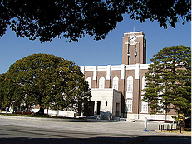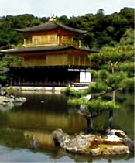|
Kyoto University | Weather | Brief View of Kyoto | Links
About Kyoto University
Nearly all conference events will be held in Kyoto University Clock Tower
Centennial Hall. Kyoto University has three campuses, and the Clock Tower Centennial Hall, the symbol of Kyoto University,
is located in the main campus of Yoshida campus.

Yoshida campus is in Sakyo (left-ward) area in the city of Kyoto. The campus
is located in the North of JR (Japan Railways) Kyoto station. Kyoto University
was founded 1897 and now is the second oldest university in Japan. Its
academic tradition is characterized as the spirit of freedom and independence,
which have been promoting various pioneering works, including the establishment
of the Primate Research Institute (located in Aichi prefecture. near from Nagoya).
 The Clock Tower Centennial Hall is fully equipped with special facilities
for academic conferences; the Centennial Hall with 500 seating capacity,
the International Conference Hall, four Conference Rooms, the University
Lounge, and more. For detailed facilities and floor plans, see here. The Clock Tower Centennial Hall is fully equipped with special facilities
for academic conferences; the Centennial Hall with 500 seating capacity,
the International Conference Hall, four Conference Rooms, the University
Lounge, and more. For detailed facilities and floor plans, see here.
Local Weather
In Japan, the rainy season usually starts in early June. The expected temperature
in Kyoto is as follows:
Highest temperature: 70~80°F
Lowest temperature: 60°F
For updated weather forecast, see here.
Brief View of Kyoto
Kyoto was Japan's capital and the emperor's residence from 794 until 1868.
It is now the country's seventh largest city with a population of 1.4 million
people.
During its millennium at the center of Japanese power, culture, tradition,
and religion, it accumulated an unparalleled collection of palaces, temples
and shrines, built for emperors, shoguns, geishas and monks. Over a dozen
of them are listed among UNESCO world heritage sites.
Eastern Kyoto, where the conference venue belongs to, embraces some of
the most picturesque parts of Kyoto. Ginkakuji (the Silver Pavilion), with a Zen garden is in a walking distance from
Kyoto University Yoshida campus. Heian Shrine with the spacious vermilion palace is a replica (built in 1895) of the
Imperial Palace of the Heian Period (794-1185), is also not far from the
conference venue. Kiyomizudera (Pure Water Temple), founded in 780, has the wooden terrace which offers
a spectacular view over the city. The Gion district, which retains traditional streets and buildings, is located
to the north-west of Kiyomizu, is where you're most likely to see geisha.
Nijyo Castle is located in Central Kyoto. It was the Kyoto residence of Edo Shoguns.
Kinkakuji (the Temple of the Golden Pavilion), covered with gold leaf and the most
popular tourist attraction in Kyoto, is located in North-western Kyoto.
It was originally built as a villa for Ashikaga Shogun in the late 12th
century.
Note most of temples and shrines require admission fees, and
close at 17:00. Many temples own their lodging complex called shukubo, and you might try to stay and experience traditional Buddhist lodging
(¥3,800~), if some inconvenience does not bother you.
Downloadable city map & guide book (new)
Kyoto map with University Area
Tourist guide (Ehglish)
Tourist guide (Japanese)
Useful links to introduce Kyoto
Kyoto--Wikitravel
japan-guide.com
Welcome to Kyoto
Kyoto Guide
Panorama Sightseeing Tour in Kyoto
Kyoto City Tourism and Culture Information System for seasonal information and links.
Kyoto Guide, with information of cuisine
Yahoo! Travel
Japanese Lifestyle
Welcome to the Kyoto Guide
Kyoto Convention Bureau with many other links.
Tourism in Japan in general
Japan National Tourist Organization
YOKOSO! JAPAN - JNTO North America Visit Japan Campaign Website |